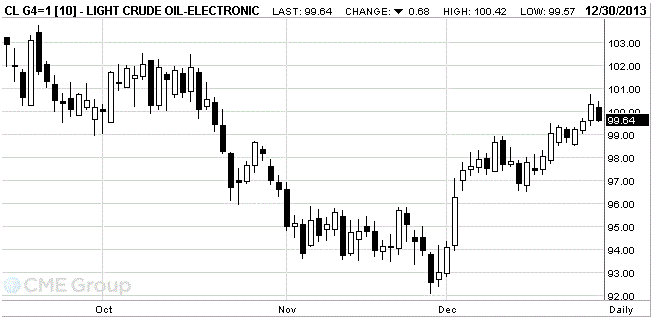Notícias do Mercado
-
16:41
Oil: an overview of the market situation
Oil prices declined moderately today , dropping below $ 112 per barrel (Brent) and $ 100 per barrel (WTI), the early signals about the fact that the supply of oil from Libya, possibly starting to recover . As it became known ,
Also on the bidding continue to affect the data on stocks . Recall that U.S. crude stocks fell the week before the fourth week in a row - by 4.73 million barrels to 367.6 million barrels. Analysts had expected a decline in reserves of 2.65 million barrels. Gasoline inventories fell by 614 thousand barrels and distillates - by 1.85 million barrels.
"Restoring the U.S. economy supports expectations of growth in demand for oil , - the head Petromatrix GmbH Olivier Jacob . - Distillate inventories by the end of 2013 have become minimal for many years, and it could mean a very low level of stocks in the spring ."
Meanwhile , we note that investors paid attention to analysts' estimates , according to which the price of Brent crude oil in the future will decrease the second year in a row on the background of significant growth in demand in the market . According to analysts Bloomberg, in 2014 the average price of Brent crude fell to $ 105 from 108.7 dollars in 2013.
The price of WTI crude oil rose 8.2 percent in December due to falling stocks , helping to reduce the gap c Brent crude to just $ 8.13 per barrel. While the spread between the two brands of oil increased today , is expected to shrink again soon , which will contribute to the launch of the Keystone XL pipeline in the United States . This pipeline will allow growth stocks at Cushing terminal , where the bulk share of refining capacity of the country.
Cost February futures on U.S. light crude oil WTI (Light Sweet Crude Oil) fell to $ 99.64 a barrel on the New York Mercantile Exchange.
February futures price for North Sea Brent crude oil mixture fell $ 1.07 to $ 111.15 a barrel on the London exchange ICE Futures Europe.

-
16:20
Gold: an overview of the market situation
Gold prices fell today , heading for its biggest annual decline in more than three decades , due to the thin trading session ahead of the holidays . Add that with the beginning of this year, prices for the precious metal fell almost 30 percent , as rising risk appetite and the prospect of global economic recovery have tarnished its appeal. Gold is generally seen as a hedge against inflation, which has ceased to be the center of attention for investors at the moment.
Experts point out that at present , the movement of gold prices is exaggerated because of the lack of liquidity, and not some macroeconomic factors.
Fall in gold prices in 2013 put an end to the 12-year growth. Gold, primarily affected by the U.S. central bank's decision to curb its monetary stimulus that raises the opportunity cost of not higher-yielding assets .
Expectations that the U.S. economy will improve, and the growth in the rest of the world will stabilize in 2014 , further reduce the appeal of gold, and investors began to invest their money in riskier assets such as stocks .
In addition, it became known that the gold reserves SPDR Gold Trust - the world's largest gold exchange-traded fund , fell by three tonnes on Friday - up to 801.2 thousand , while reaching the lowest level since January 2009 .
The data also showed that China's net imports of gold from Hong Kong fell by 42 percent - up to 76.393 tons in November to 131.19 tons in October, reflecting a drop in demand after strong purchases in previous months.
Cost February gold futures on the COMEX today dropped to $ 1206.00 per ounce.
-